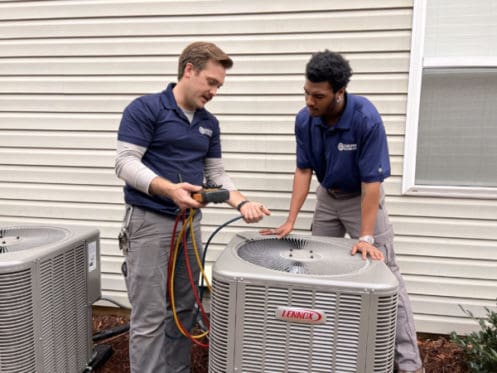Your heating system is your best friend on cold winter nights in Charleston, South Carolina. It’s comforting to know that when you turn up the thermostat the temperature in your home will rise. However, you may be confused about the basics of your HVAC system. You may have questions about what components you need to purchase, repair, maintain, or have repaired by a professional. The following guide will give you an overall picture of your HVAC system.
What Does HVAC Mean?
HVAC is an acronym for the terms describing the different functions of your unit: heating, ventilation, and air conditioning. It heats and cools your home with your furnace and air conditioner, and a method of ductwork and vents is used to circulate air through your home.
The Primary Components of Your HVAC System
Your furnace has four key components. The burner is what delivers fuel and burns it. The heat exchanger and the blower work together to take the heat produced by the burner, use it to heat the surrounding air, and then send it through the air ducts. Finally, the flue is the exhaust system, allowing dangerous gas and other byproducts to escape the home.
The air conditioner cools the home by pulling out the heat energy inside the house and transferring it outside. Most homes have a split system where the evaporator is inside the home and the heat exchanger or condenser is outside the home. Your air conditioning unit will use a combination of coils, blowers, and heat-absorbing fluids to cool your home.
Your HVAC unit may include a heat pump. This is an energy-efficient device that can be used to heat and cool your home if you live in a mild climate. It uses the outside air to heat the house during the cold season and to warm the home during the summer.
The air handler works with the heat pump to distribute air throughout the home. You do not need an air handler if you have a traditional, all-in-one air conditioner and furnace system.
The thermostat serves as the brain of your unit. You may have a traditional thermostat or a connected control thermostat. Connected control thermostats will work with smart systems in your home. They will learn over time how to effectively heat and cool according to your schedule. A traditional thermostat is relatively simple but has some basic programmable features.
How Does the Heat Exchanger Work?
The heat exchanger sits in the housing of your furnace. It absorbs heat from the fuel source and warms the cool air surrounding it. The thermostat activates the furnace, telling it to create heat.
All furnaces have some type of heat exchanger, even electric units. The heat exchanger is built with strong stainless steel and other temperature-resistant materials. This allows it to heat and cool repeatedly without cracking or sustaining other damage. Advanced models have additional ducts that enable you to heat your home faster.
Heat exchangers need to be maintained frequently. A crack in the heat exchanger could lead to a carbon monoxide leak in your home. This could affect the health of your family and even lead to death. Carbon monoxide does not have color or odor, so it can affect you without you knowing it. For this reason, Charleston Heating and Air invites you to contact our technicians and have us inspect your HVAC system to identify any potential problems before they become serious.
How Does the Motor Blower Work?
Once the heat exchanger reaches the desired temperature, the electric blower motor activates. A powerful fan forces the warm air from the furnace into your home’s ductwork. The air travels to the registers and then permeates the rooms in the home.
The burners in your furnace will turn off before the blower motor stops working. This allows all of the warm air in the heat exchanger to get to the rooms of your home before the motor turns off and waits for the next heating cycle.
Some blowers have speed controls that allow them to distribute air precisely around the home. These advanced systems will monitor the HVAC system and compensate for any problems by increasing or lowering treated air distribution. A variable speed blower motor gradually reaches full speed. So, they’re not noisy and are an effective tool for reducing humidity in the summer. Since your home will likely reach the desired temperature before a variable speed unit reaches max speed, you save on energy costs.
How Does the Combustion Chamber Work?
The combustion chamber of your HVAC system allows air and fuel to mix correctly. In a gas furnace, the heating cycle begins when a minute amount of air and gas is incorporated into the combustion chamber. A pilot light or a glow stick will ignite the mixture. It will burn as a controlled fire. Systematically, more air and gas are directed to the burner, increasing the temperature of the heat exchanger.
Some high-efficiency models will use a secondary combustion chamber that gathers the carbon monoxide and unburned fuel, recompresses it, and then ignites it again. This ensures you get all the heat energy from the natural gas or the other fuel source you use. Newer models may come equipped with integrated circuit boards that allow you to monitor the combustion process remotely and receive warnings if there is a problem.
How Do the Condenser Coil and Compressor Work?
You will find a condenser coil in your air conditioner or heat pump. This is the part of the unit that is installed outside of your home. This unit will cool your home by releasing heat outdoors. The unit compresses and condenses refrigerant from a warm gas to a cool liquid. As this happens, a fan pushes air over the compressor, dispersing the heat while accelerating the cooling of the refrigerant. The refrigerant liquid is sent to the evaporator coil via an aluminum- or copper-lined tube.
How Does the Evaporator Coil Work?
The evaporator coil is the part of your air conditioner inside your home. The cool refrigerant travels from the condenser to the evaporator coil, which absorbs the heat of the air being blown over it and lowers your home’s temperature. Once that’s done, the refrigerant is sent back to the condenser coil to begin the cooling process again. In addition to lowering the temperature in your home, your air conditioner also lowers the humidity levels in your home. This makes it feel more comfortable during the summer months.
Experience Quality Plumbing and HVAC in Charleston, South Carolina
Working with an HVAC company that you can trust is an amazing experience. We work hard to ensure that you have the best service possible. There are many preventative maintenance programs that we offer as a package to keep your entire home running smoothly.
When you need HVAC or plumbing help in Charleston, South Carolina, Charleston Heating and Air is your team. We care about your comfort. We proudly offer professional heating, cooling, plumbing, and maintenance services. We love hearing from new customers and enjoy working to help make their homes as comfortable as possible. Call Charleston Heating and Air today to learn more!

